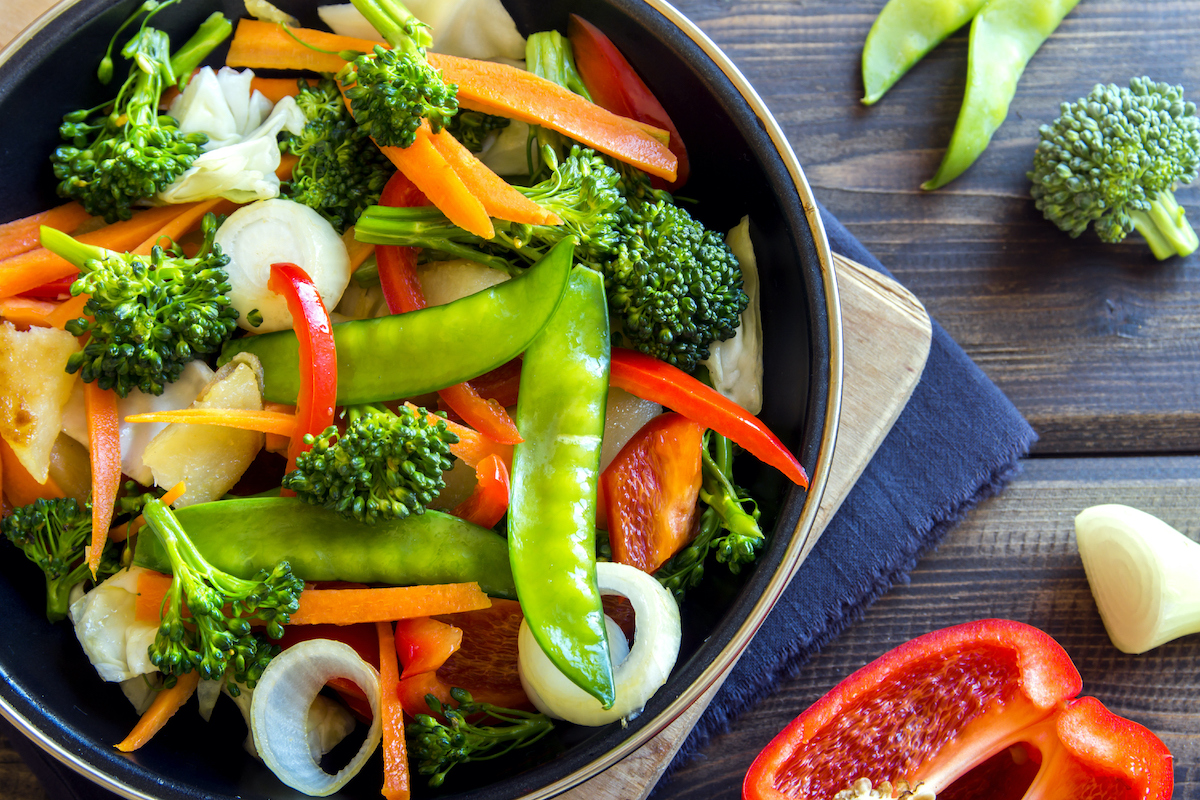Stir fry is such a magical meal because you can put whatever you want in it and it comes out different every time! It’s a fantastic way to use up odds and ends as you clean out the fridge before your next shopping trip. As a plant-based chef, I jokingly refer to stir fry as a “trash” meal because it is best with a wide variety of vegetables and so it’s a great way to use up all of the odds and ends hanging out in your fridge! Stir fry is enjoyed with a grain or noodle, and always has an incredible sauce to bring it all together.
This concept of framework cooking might be new, and this method is a great way to really understand what this strategy and lifestyle is all about. Follow these simple steps, and if you need some additional inspiration I’ve left you with some of my favorite combinations at the end!
How to Make a Stir Fry: the Basic Framework
Like I mentioned earlier, you can use pretty much anything from the fridge to make a stir fry. The framework for cooking will always remain the same, no matter what ingredients you use.
Stir Fry Framework
- Start with aromatic veggies first.
- Add more delicate veggies.
- Get saucy!
- Serve over a grain.
- Top it off!
1. Start with the Aromatics
Begin with your aromatic vegetables: onions, garlic, carrots, and celery. Make sure to chop them small. Stir fry should be a fast meal to prepare, so you’ll notice that bite-size veggies are important here.
Heat a large pan or wok over medium-hot heat, and add a little avocado oil. If you’re on an oil-free protocol, simply use water. Once the pan and oil are hot, add the aromatic veggies.
2. Add More Delicate Veggies
After about five minutes, add more delicate veggies like peppers, mushrooms, squash, and cruciferous greens like chopped chard, kale, broccoli, or cauliflower. Continue cooking for another 5-10 minutes until the veggies are cooked to your liking.
It is important not to overcrowd the pan or wok, or the veggies won’t cook properly. A pan that’s too full will keep the water trapped and will result in steamed veggies, not a golden and crunchy stir fry.
3. Get Saucy!
This next part is where it gets really exciting – it’s time to add the sauce! I like to start with a base of tamari and water, in a 2:1 ratio, with a little rice vinegar added for acidity. From there, you can add whatever else you like – fresh garlic, fresh ginger or ginger essential oil, lemongrass essential oil, nutritional yeast, mustards, spices, etc.
When you have your sauce mixed up to the flavor that you like, add a little cornstarch, arrowroot, or xanthan gum. What you’re making here is called a slurry or whitewash. It’s important to thoroughly whisk the thickener into the liquid so that there are no lumps. If the sauce sits for too long, the thickener will settle, so be sure to stir it again before adding to the pan. A good ratio here is one tablespoon of thickener per one cup of liquid. If you’re using much less than one cup of liquid, use a ratio of one teaspoon of thickener to ⅓ cup of liquid.
Before adding the sauce to the pan, move the veggies to the outside so the sauce and thickener can activate from contact with the heat of the pan. It takes just a minute, at most, to thicken so pay attention and stir the veggies back in after about thirty seconds. I like to prepare more sauce than I think I’ll need because the grain or noodles will absorb some of the sauce. And there is nothing worse than a dry stir fry.
4. Serve Over a Grain
If you’re following the batch cooking method, you likely have a cooked grain on hand to use up. If you don’t have any already cooked, I prefer to make what I need the night before because I find it easier for timing. Brown rice, black rice, farro, quinoa, buckwheat, groats, cauliflower rice, or noodles are awesome to use in a stir fry. If you opt for the noodles, the recipe will lean more towards a lo mein or pad Thai.
5. Top It Off!
Top with hemp seeds, sesame seeds, scallions, fresh herbs, lime juice, or a quick peanut sauce. Simply thin out some peanut butter with a little water and tamari/rice vinegar, with a dash of maple syrup if needed.
Flavor Inspiration
This method is not limited to Asian flavors!
Make a quick Italian style dish by using the same framework, just swap out the tamari based sauce for marinara, cashew alfredo, or pesto.
Are you partial to Mexican flavors? Make a burrito-style fried rice with tomatoes, peppers, greens, avocado, black beans, cumin, nutritional yeast, and salsa.
Experiment with your own combinations and let your creative plant-based juices flow.
More Stir Fry Flavor Combinations
- Classic teriyaki: maple, garlic, ginger or Ginger essential oil
- Simple + savory: organic miso paste, nutritional yeast, ketchup
- Flavor master: rice vinegar, Lemongrass, Ginger, cilantro or Cilantro essential oil
- Spicy stir fry: red curry paste, almond butter, coconut milk
The possibilities are endless, and you will soon learn that so many of your new favorite meals can be created with ease using this guide.
Hungry yet? Give this technique a try next time you have a fridge cleanout to conquer!











Join the GloWell Community on Social!
Don't risk missing a single thing. Follow us on social and become part of the GloWell community.